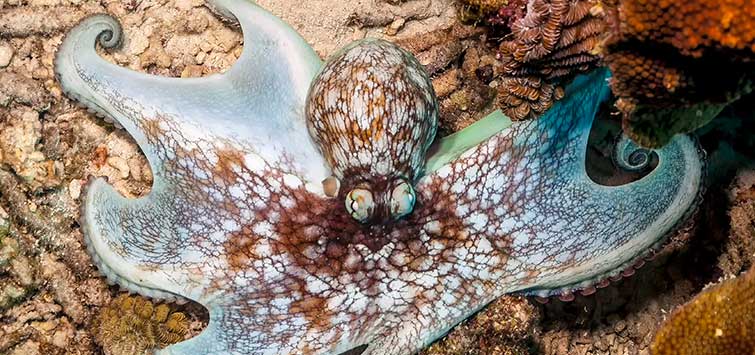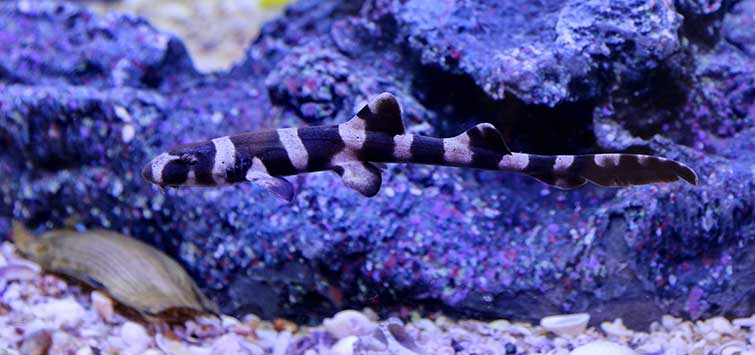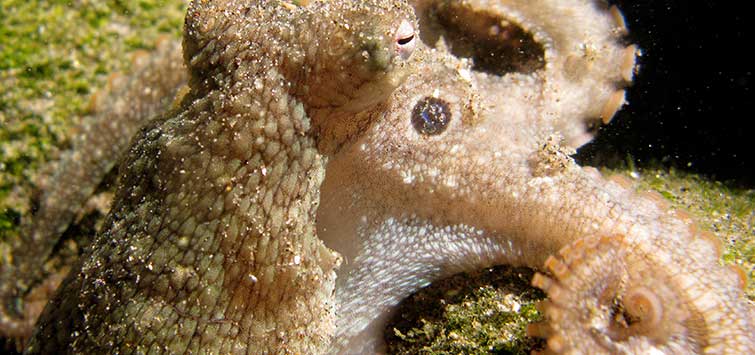So You Want to Keep an Octopus…
Author: Nancy King
Octopuses exhibit intriguing behavior, surprising intelligence, and incredible shape- and color-changing abilities in the aquarium—as well as tragically short lifespans.
Mysterious Yet Graceful
An octopus is one of the most fascinating and rewarding marine creatures you can keep in the home aquarium. Octopuses interest us with their behavior, their ability to learn, their interaction with us, and their incredible shape- and color-changing abilities. They are intelligent creatures and have their own personalities. If you’re willing to take some time and effort, and you can afford shrimp and crabs for food, then maybe you’d like to consider keeping an octopus.
Drawbacks
Some of the negatives of octopus-keeping include the short lifespan (less than a year for most), high cost of food, tendency to hide or remain camouflaged when you most want to see them, and the very restricted list of possible tankmates. You probably won’t be able to keep your favorite fish and corals in the same tank with the octopus. It’s also difficult for reef-tank owners to give up the sophisticated equipment (metal halide lights, UV filters, wavemakers, etc.) that are unnecessary and undesirable for an octopus.
Simple Tasks
Octopus-keeping can be easy in that they only need simple wet-dry filtration, don’t require much light, and don’t demand many of the precise conditions that sessile reef invertebrates need.
Challenges
There are also several challenging aspects of octo-keeping. Providing adequate food is the most difficult task for many, especially because favorite octopus foods like crabs and other crustaceans are expensive and hard to come by. Octopuses need some live food for enrichment and nutrition, but most also accept frozen shrimp and a few other foods.
The staple for octopus diets is often thawed frozen shrimp, supplemented with live crabs. Octopus-keepers living along the coast have an advantage because they have easier access to foods. Some find food along the shore, while others buy from bait shops or seafood stores. Octopus-keepers living further inland must rely on crabs and shrimp being shipped to their location. This can be expensive and incur delays.
How Do They Behave and Interact?
The dwarf species available now are often nocturnal and don’t interact much, but they can be fun to watch under a red light, which is invisible to the little octopus. The medium-size diurnal octopuses generally available are often interactive and can be interesting to observe and fun to play with. Many can be taught to open simple jars if a nice tasty crab is inside.
They might also surprise you with some of their other incredible activities. It’s common for them to accept food from your hand or a feeding stick, and they will often come out to observe you.
Where Do I Find Them?
Octopuses are available from a number of sources. Local fish stores sometimes carry octopuses, or can at least order them. Occasionally, owners raise hatchlings and sell them publicly, which makes them the best source for tank-raised specimens. Live-rock farmers, usually in Florida, often have octopuses for sale and are a good source for dwarf octopuses.
Also, some wild-caught octopuses are offered on the Internet. The “Octopus Availability” thread on www.tonmo.com lists many current sources for octopuses. A few home aquarists acquire their octopuses as hitchhikers on live rock.
What Species are Available?
It’s common for fish stores and suppliers to offer octopuses with no species identification. They may be listed as “assorted octopuses,” “brown octopuses,” or some other vague term. Sometimes the identification is faulty; dwarf octopuses have been sold as Octopus vulgaris, a much larger species. Try to find out what part of the world your octopus comes from, because this will help with later identification. Sometimes a home aquarist may acquire a rare and unusual species without even knowing it.
Bimacs
Octopus bimaculoides (bimac) is perhaps the most popular species, being easy to keep, reasonable in size, and sociable. It lays large eggs, which offers the possibility of raising the hatchlings. A bimac requires at least a 50-gallon tank, but many octopus-keepers put this species in even larger tanks to give their bimacs more room to explore and swim. Found along the coast of California, the bimac comes from cooler waters and can be kept as low as 59°F, yet many have successfully kept this octopus at room temperature. It’s better to try to keep the tank temperature in the lower 70s or below, using a fan on the sump or some other means.
Mercatoris
Octopus mercatoris, a dwarf octopus from the Gulf of Mexico, is the best octopus for smaller tanks. A 30-gallon tank makes a good home for this small, nocturnal octopus. It can live in a shell or a small den, and can be viewed using a red light at night. Keep it at 74° to 76°F.
Briareus
Octopus briareus is a reef octopus with long legs. It can be kept in a 50- to 75-gallon tank (or even larger) with the water at about 78°F. Although nocturnal, most will come around to appearing during the day. They can be friendly and social. This species also has large eggs, so it’s possible to raise the hatchlings.
Abdopus aculeatusis
Abdopus aculeatusis now coming on the market, especially in California aquarium stores. It’s known as the walking or bipedal octopus and has the advantage of being social and interactive. It comes from tropical waters and likes a tank temperature of 78°F. A 50-gallon tank or larger provides a good home for this octopus.
Octopuses to Avoid
Hapalochlaena lunulata
The blue-ringed octopus Hapalochlaena lunulata is not a choice for a pet octopus. This small octopus is known for its bright blue rings when threatened, a warning that it is about to bite. The blue-ringed octopus carries venom with a powerful nerve toxin for which there is no antidote. It’s a very dangerous animal to keep, even if you think you’ve taken every precaution. There are much better octopuses for the home aquarist, and this species should only be kept by a public aquarium.
Striped Octopus
A second group of species to avoid is the zebra or striped octopuses: wunderpus and mimic octopuses. The status of these octopuses is not known, and they may be close to endangered, so purchasing one only encourages the capture and sale of others. These octopuses are expensive and difficult to keep, and most have reached maturity by the time they’re offered for sale, so they may last only a month in your tank. A much better choice would be A. aculeatus.
Tank Requirements
As the Cephalopod Care co-moderator on www.tonmo.com, I have had the opportunity to follow well over 100 octopuses through their lives. As octopus-keepers, we have all learned from each other on the “Ceph Care” forums and have had the opportunity to see what works best for successful octopus-keeping.
The best way to keep an octopus is actually the method we originally recommended: a tank of adequate size or better, lots of live rock in the tank (a pound per gallon), a one-inch sand bed, a wet-dry filter and sump, protein skimmer, powerhead for extra circulation, and a simple fluorescent light. No fancy equipment is needed—no metal halides (too much light), no UV filter, no wavemakers or other devices that a reef tank might require.
Make sure no copper has ever been used as a treatment in the tank you are using; copper is deadly to octopuses. Also, the tank must be very well cycled, and this will take three months or more if you’re just starting. Water quality is important, too. Start with RO/DI water—available at your local LFS—and use a good-quality salt mix.
Octopuses are especially sensitive to pH and ammonia. Water parameters should be: specific gravity about 1.026, pH around 8.2, nitrites and ammonia 0. Some nitrates can be tolerated—aim for less than 30 ppm.
Some Special Considerations
Feeding
Locate sources for food before you acquire an octopus, and price the cost of live crabs. You may be surprised at the expense of feeding, considering that you should provide some live food. You will spend much more on food than the cost of your octopus (unless you can catch your own octo food).
Constant Care
Octopuses require attention and care. It’s difficult to leave for a vacation (as it is with a reef tank). Avoid keeping them in an office or dormitory where they will be unattended for weekends or longer.
Escape Artists
Regardless of what you might read, octopuses do try to escape. Make sure the lid on the tank is well sealed (duct tape is your friend). Also, intakes and outlets within the tank should be protected with a sponge or mesh secured by rubber bands or cable ties.
DÉcor
Rocks in the tank must be very stable. With its great strength, even a small octopus can topple your rock structure.
Nothing is sacred within your tank. Be prepared for your octopus to romp around the tank, rearrange rocks and shells, dig through the sand down to the glass, and generally change the overall setup. They do this more as they get older.
Tank Parameters
Because of its sensitivity to ammonia and nitrites, your octopus must be put in a well-cycled tank—one that has been running for at least three months. There are no shortcuts; no chemicals can be used to speed up the process.
Acclimation
It’s important to acclimate your new octopus upon its arrival, and this should be done slowly, using a drip line.
The First Weeks
The first few weeks can be trying for an octopus-keeper. You’ve just put your new specimen in its tank, it disappears for days, and you worry that it isn’t eating. This is common behavior for an octopus stressed by shipping or being placed into a new environment. To make this worse, your octopus may be dining on amphipods and ignoring the crabs and snails you carefully put in the tank for it.
If you don’t see your octopus at first, don’t take apart the live rock looking for it, this will only disturb it more. Just be patient, make food available, and watch carefully. Because of its excellent camouflage abilities, your new pet may be right in front of you and you can’t see it.
Octopus Lifespan and Reproduction
The sad part of keeping an octopus is the short lifespan. Most last less than a year as pets because they’re already a few months old by the time they arrive. Under ideal conditions, bimacs have been known to live two years, but most home aquarists find them coming to the end of their lives at about 12 to 14 months.
Dwarfs live six to eight months, and larger octopuses like O. vulgaris live even longer. The giant Pacific octopus Enteroctopus dofleini, which requires such a large tank and cold water that it’s rarely kept by individuals, may live up to five years.
An odd thing about octopuses is that eggs are laid near the end of the female’s life. A male can transfer a sperm packet to her quite early in her life, and this accounts for eggs being laid in a tank with only one octopus.
The first sign an octopus-keeper may see is den building. The female builds a den for herself and her eggs, and her behavior may seem odd. When the eggs are laid, the female retreats to the den to protect and take care of the eggs. She may or may not eat during this period, but food should be offered. Around four to six weeks later the eggs hatch and the female usually dies within a few weeks.
If your octopus happens to be male, it will eventually become senescent and die soon afterwards.
Do Octopuses Bite?
Yes, octopuses can bite. None of the species we commonly keep are defensive biters, so it’s more of a curiosity bite, or just to see if you’re edible! Usually they try this only once. It’s possible to avoid getting bitten by not letting the octopus come down on your hand and enveloping it with its mantle.
Most people have survived octopus bites with no problem other than a stinging sensation like a bee sting. It’s also wise to avoid submerging a hand with any sort of wound into your tank, since you could get an infection. Dwarf octopuses often have a more potent bite than the larger octopuses we keep. Many pet octopuses never bite their owners. Nevertheless, be careful!
Octopus Play
Some octopuses like to play with toys. Most will play tug of war with a feeding stick and maybe even your hand. Others prefer a pile of shells to sort through, various baby toys such as a string of plastic rings, toy building blocks, or a construction of drinking straws. Octo-keepers have taught their octopuses to open a jar or container with a crab inside, starting with the lid barely screwed on. The hand of its keeper is also a favorite toy for the octopus.
Why Keep an Octopus?
Keeping an octopus enables you to experience one of the most intelligent animals in the sea, one that is interesting to observe and offers the possibility of interaction. Keeping an octopus tank is much different from keeping a reef tank, which is fascinating in its own right.
Many people are intrigued by these animals and want to know more about them. I found that by introducing others to my octopus tank I promoted a real appreciation of intelligent marine life, which might lead to more care and concern about all sea life.
For More Information
The Octopus News Magazine Online, www.tonmo.com.
Ceph Care Articles and Forums. CephBase, http://www.cephbase.utmb.edu/.
The Cephalopod Page http://www.thecephalopodpage.org/.
Norman, M. Cephalopods, A World Guide—Octopuses, Argonauts, Cuttlefish, Squid, Nautilus. Hackenheim: ConchBooks, 2000.

.png?h=595&iar=0&w=2781&hash=5FD5E69473BCC22199FBFA2FB71B6033)



